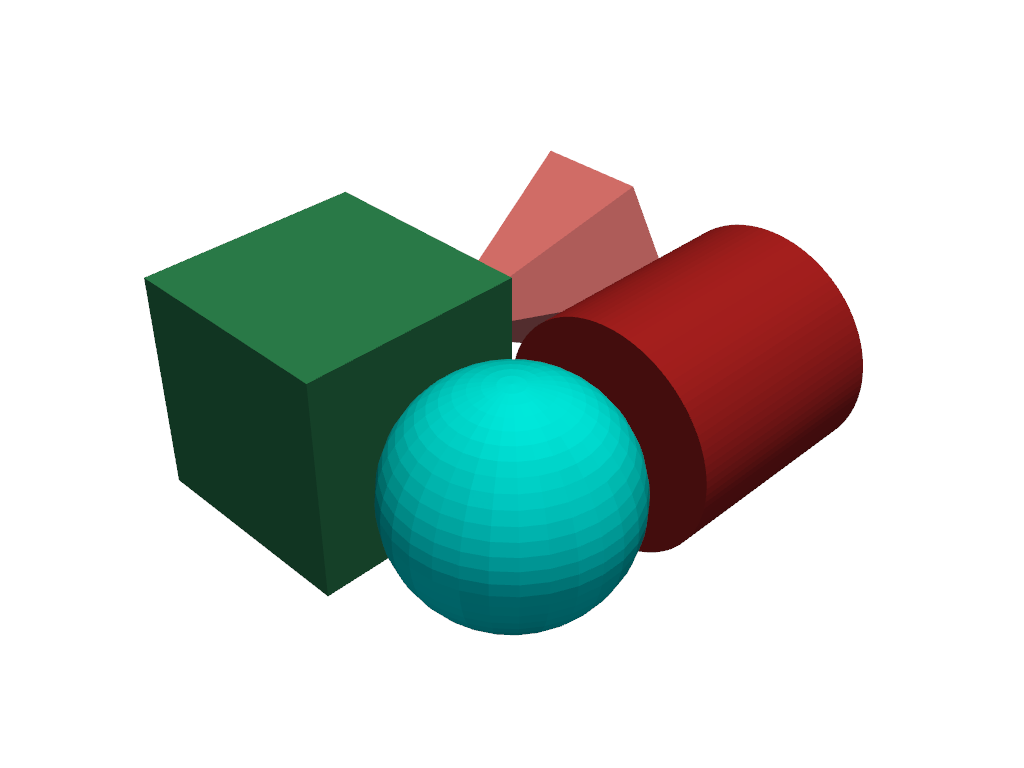Note
Go to the end to download the full example code.
Color Cycling#
Cycle through colors when sequentially adding meshes to a plotter.
Many plotting libraries like Matplotlib cycle through a predefined list of colors to colorize the data being added to the graphic. PyVista supports this in much the same way as Matplotlib.
from __future__ import annotations
import pyvista as pv
Turn on color cycling in PyVista’s theme and set it to use the default cycler.
pv.global_theme.color_cycler = 'default'
List the available colors in the cycler
Create a plotter and add data to the scene. You’ll notice that each
add_mesh call iterates over the colors in pv.global_theme.color_cycler
pl = pv.Plotter()
pl.add_mesh(pv.Cone(center=(0, 0, 0)))
pl.add_mesh(pv.Cube(center=(1, 0, 0)))
pl.add_mesh(pv.Sphere(center=(1, 1, 0)))
pl.add_mesh(pv.Cylinder(center=(0, 1, 0)))
pl.show()

Reset the theme to not use a cycler and instead set on individual plotters.
pv.global_theme.color_cycler = None
If you do not want to set a global color cycler but instead just want to
use a cycler for a single plotter, you can set this on with
set_color_cycler().
pl = pv.Plotter()
# Set to iterate over Red, Green, and Blue
pl.set_color_cycler(['red', 'green', 'blue'])
pl.add_mesh(pv.Cone(center=(0, 0, 0))) # red
pl.add_mesh(pv.Cube(center=(1, 0, 0))) # green
pl.add_mesh(pv.Sphere(center=(1, 1, 0))) # blue
pl.add_mesh(pv.Cylinder(center=(0, 1, 0))) # red again
pl.show()

Further, you can control this on a per-renderer basis by calling
set_color_cycler() on the active
renderer.
pl = pv.Plotter(shape=(1, 2))
pl.subplot(0, 0)
pl.renderer.set_color_cycler('default')
pl.add_mesh(pv.Cone(center=(0, 0, 0)))
pl.add_mesh(pv.Cube(center=(1, 0, 0)))
pl.add_mesh(pv.Sphere(center=(1, 1, 0)))
pl.add_mesh(pv.Cylinder(center=(0, 1, 0)))
pl.subplot(0, 1)
pl.renderer.set_color_cycler(['magenta', 'seagreen', 'aqua', 'orange'])
pl.add_mesh(pv.Cone(center=(0, 0, 0)))
pl.add_mesh(pv.Cube(center=(1, 0, 0)))
pl.add_mesh(pv.Sphere(center=(1, 1, 0)))
pl.add_mesh(pv.Cylinder(center=(0, 1, 0)))
pl.link_views()
pl.view_isometric()
pl.show()

You can also change the colors of actors after they are added to the scene.
ProTip: you could place the for-loop below in an event callback for a key event to cycle through the colors on-demand. Or better yet, have your cycler randomly select colors.
from cycler import cycler
pl = pv.Plotter()
pl.add_mesh(pv.Cone(center=(0, 0, 0)))
pl.add_mesh(pv.Cube(center=(1, 0, 0)))
pl.add_mesh(pv.Sphere(center=(1, 1, 0)))
pl.add_mesh(pv.Cylinder(center=(0, 1, 0)))
colors = cycler('color', ['lightcoral', 'seagreen', 'aqua', 'firebrick'])()
for actor in pl.renderer.actors.values():
if isinstance(actor, pv.Actor):
actor.prop.color = next(colors)['color']
pl.show()

Total running time of the script: (0 minutes 1.097 seconds)